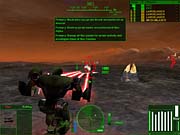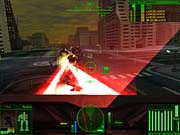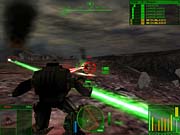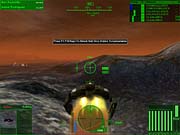The futuristic yet rugged form of the BattleMech has long since become an icon in PC gaming. Years ago, these gigantic bipedal tanks were ripped from the BattleTech pen-and-paper role-playing game and have since become the subject of a slew of action-packed simulations. The license to BattleTech bounced around over the years until Microsoft finally claimed it--a seemingly permanent resolution. Microsoft has already delivered a couple of solid MechWarrior games, including this year's well-received real-time strategy game MechCommander 2 and last year's MechWarrior 4: Vengeance. The latter game did an excellent job of bringing the world of BattleTech to life--it managed to render mechs with an acute attention to their monstrous proportions. But its graphics weren't its only strong suit, as MechWarrior 4 excelled as a multiplayer game. The game balanced action-packed combat with simulation elements, a combination that pleased many players but still didn't appeal to some of BattleTech's hard-core fans.

Nevertheless, the game was successful enough to justify the new expansion pack, MechWarrior 4: Black Knight--which, unfortunately, doesn't tie in with the forthcoming movie starring Martin Lawrence. Black Knight, which requires that you have MechWarrior 4 installed, does introduce a challenging single-player campaign with a dynamic mission structure; a number of new mechs, including the imposing Black Knight itself; and some interesting new multiplayer modes to bolster MechWarrior 4's already good multiplayer options. These additions are sound--they extend and expand on the original game's context in meaningful ways--though they might have given a stronger impression if Black Knight weren't a full year older than, and just as expensive as, its predecessor.
Interestingly, MechWarrior 4: Black Knight was developed by CyberLore Studios, rather than by the same team that did the original game. CyberLore has built up an unusual portfolio for itself over the years, which includes the official expansion packs to the popular strategy games Warcraft II and Heroes of Might and Magic II, as well as its own critically acclaimed strategy game, Majesty--and the expansion pack to that. Clearly, CyberLore knows its expansion packs. It's been making them since before they were in style. Even so, Black Knight is a departure for the company in some ways--it's a graphically impressive fully 3D game, rather than a simple-looking real-time strategy game. On the other hand, Black Knight actually has a lot in common with CyberLore's previous expansion packs, which were technically good but stayed very true to their predecessors.

The "Black Knight" in the title refers to the notorious mercenary group that you will help lead throughout the expansion pack's new campaign. After fighting for the good guys of the Inner Sphere in the last few MechWarrior games, it's nice to play as the gun-for-hire again, just as you did in MechWarrior 2: Mercenaries, the follow-up to Activision's classic mech sim. Although, as you might expect, the Black Knights won't seem quite as dastardly as they're made out to be, but rather like a typical battle-hardened regiment of soldiers. The game's plot unfolds in some brief noninteractive sequences using the game engine, but mostly through voice-over between characters. The voice work is well done, but alone it doesn't manage to make Black Knight's story very engaging, especially when measured against games like MechCommander 2, which made good use of full-motion video sequences to provide a better sense of context and purpose for the action.
The campaign missions themselves are tough and reasonably varied, and they take you through five operations in a number of colorful environments, from molten wastelands to ruined metropolises to resource-rich mineral fields filled with crystalline outcroppings. The campaign isn't completely linear--the success or failure of certain objectives may yield different options for the next mission. In the mech lab, between scenarios, you'll have a chance to trade salvaged equipment on the black market to get your hands on better gear. You can use this to customize your mechs more than you might otherwise be able to with just the battlefield salvage. But having more options in the mech lab means having an even greater responsibility for custom-tailoring your mech as best you can. The difficulty of some of the scenarios will make you frequently revisit your mech designs, tweaking their loadouts with the prescience of what your enemies will bring to the fray.
MechWarrior 4 was a great multiplayer game, if not inherently because it let you pit your best mech configuration against fellow human opponents, then just because the action was generally fast and smooth even over a dial-up connection. Black Knight expands on the original game's multiplayer options by introducing several new modes of play, which are fairly predictable variants on other popular multiplayer modes. For instance, the new "mech strongholds" mode requires teams of players to defend key installations while trying to destroy those of the enemy. The "siege assault" mode is similar, but the teams decide in advance which will defend and which will attack.

A couple of the other new modes, "goliaths" and "Clan vs. Inner Sphere," are inherently unbalanced. The former pits teams of light mechs against heavier ones, while the latter--true to the BattleTech fiction--pits the relatively weaker Inner Sphere mechs against the technologically superior Clan mechs. Fortunately, these modes, along with the new "attrition" deathmatch variant, all use a damage-to-mech-tonnage ratio for determining the final scores, which gives smaller mechs a fighting chance at least on the scoring screen. The team-focused multiplayer modes of Black Knight can be fun, and it's easy to find a game by using the built-in server browser. But then again, the original MechWarrior 4 offered a lot of variety in its multiplayer mode to begin with, so the new modes offered in Black Knight yield diminishing returns.
MechWarrior 4 looked spectacular when it was released a year ago, and it still looks excellent--though perhaps not quite as dramatic as it used to. Still, the white-hot weapon effects, the blistering explosions, and certainly the gigantic mechs themselves remain a pleasure to watch and still sound good. The new mechs, vehicles, and weapons, as well as the new environments added in Black Knight, blend in well with the original game's content--to the point where it can be difficult to tell the old from the new. Most of the new mechs--even the light ones--have a default configuration that packs a serious punch, thanks to concentrated arrays of energy weapons. Expect to get right up in the enemy's business in Black Knight's new mechs.

That's not to suggest Black Knight plays much differently than MechWarrior 4 did, because it doesn't. Hard-core BattleTech players who were disappointed by MechWarrior 4's action-oriented battles will find more of the same thing, only tougher, in Black Knight. For the same reason, those who found MechWarrior 4's campaign to be enjoyable but fairly easy will appreciate the greater challenge in Black Knight, even if it is similar. The multiplayer action is similar too. This isn't to say that the additions in MechWarrior 4: Black Knight are insubstantial--only that they aren't necessarily justifiable. Think of it this way: Black Knight is a game about mercenaries, so you might as well take a mercenary approach toward the game itself. What price do you put on five more mechs, a new campaign, and some more multiplayer modes? Probably not $30, which is the asking price for Black Knight and incidentally also the asking price for the original MechWarrior 4.
In the mid-'90s, expansion packs were almost always bad news. They were scenario collections that were hastily thrown together and were sold for a significant percentage of the original game's cost. With Beyond the Dark Portal for Warcraft II, CyberLore Studios helped show that a higher level of quality could be expected from such products. By now, many expansion packs are actually very good. Unfortunately, somewhere along the line, they also started selling for 50 percent more than they used to. And that $30 price point is really the only serious problem with MechWarrior 4: Black Knight. Still, it's a mercenary world--since mech simulations aren't nearly as common as they used to be, if you're a fan, then you'll have to take what you can get. Especially now that EA and Kesmai's BattleTech 3025 is looking like it may never see the light of day, there's all the more reason why players itching for more mech combat might as well get Black Knight, if not because it's a good add-on to a great game, then because there's no alternative.